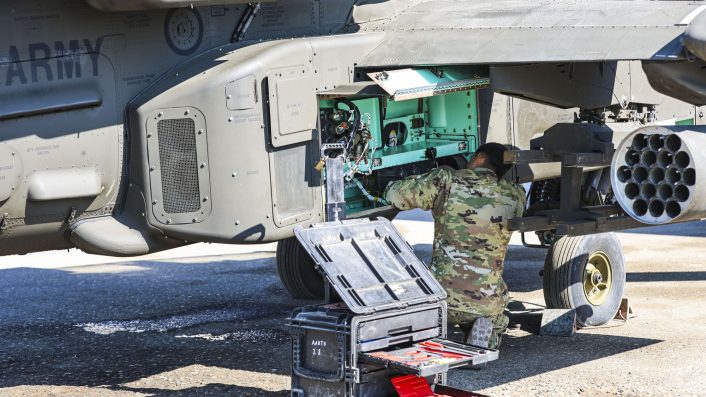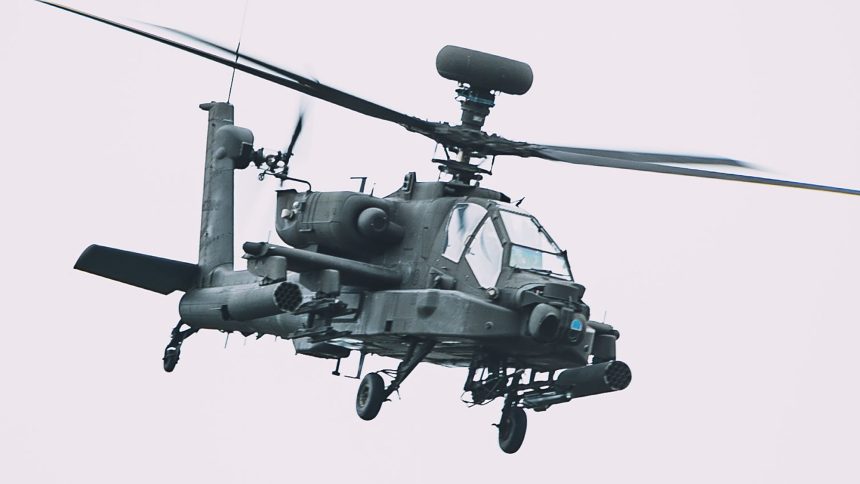Intel’s Altera developed the MCP-2 that can be customized to different functions. The Gen 3 RFI systems will be powered by this ‘state-of-the-art microelectronics and modern software capabilities,’ offering ‘improved sensor performance in a smaller, lighter package for the Apache’.
The U.S. Army’s AH-64 Apache helicopters’ new enhanced EW (Electronic Warfare) upgrade by Lockheed Martin will be powered by a new series of microelectronics, circuits and a top-of-the-line microchips developed by Intel. As per a contract awarded by the AAHPMO (Apache Attack Helicopter Project Management Office), the company will develop the Gen 3 RFI/RWR (Radar Frequency Interferometer/Radar Warning Receiver) APR-48B system for the fleet.
The statement by the company said that, over the next several years, Lockheed Martin will partner with the AAHPMO “to implement, design, test, produce and deliver the Gen 3 RFI System.” The company has previously developed, produced and installed Gen 1 and Gen 2 RFI systems for the Apache. “The Gen 3 RFI system will provide significant capability enhancements that are enabled by advanced microelectronics,” the statement added.
The Gen 3 RFI system is a product of Lockheed’s ongoing collaboration with Intel’s Altera and Booz Allen Hamilton. Other authorities involved in the project include the Office of the Under Secretary of Defense for Research and Engineering (OUSD R&E) and two initiatives by the Trusted and Assured Microelectronics (T&AM) program – Stimulating Transition for Advanced Microelectronics Packaging (STAMP) and State-of-the-Art Heterogeneous Integration Packaging (SHIP) projects.
U.S. Army Soldiers assigned to the 12th Combat Aviation Brigade prepare to take flight in AH-64 Apache helicopters at Hohenfels Training Area, Germany. pic.twitter.com/MRCNYZ0kpx
— US Army Aviation and Missile Command (AMCOM) (@USARMYAMCOM) October 14, 2024
Need for EW-capable Apaches
This upgrade for the attack helicopter is in line with both the technological and tactical imperatives in the ongoing war in Ukraine and possible flashpoints in the western Pacific where both Russia and China have demonstrated advanced electromagnetic spectrum capabilities. Wars with a peer rival will be in highly contested battle spaces, requiring aerial platforms to be more survivable, to jam, prevent jamming and undertake fires while also defeating incoming enemy missiles.
In fact, the latest contract underscores the critical role of attack helicopters in the European theater and the significance of electronic warfare (EW). The U.S. is shifting focus back to the helicopter’s Cold Wars-era role for the massive land war that might potentially emerge with Russia.
Moscow leads both in diversity and sophistication of both its EW systems and its attack helicopter fleet (Ka-52, Mi-28 and Mi-35). Moreover, it uses dedicated EW helicopters like the Mi-8 MTPR-1 to accompany its strike helicopters, unburdening a lot of the load on the attack helicopters.
The war in Ukraine has also seen both NATO and Russia learning the limitations of their AD (Air Defense) systems, with Russia particularly possibly looking to enhance the seekers and guidance systems of its Tor and Pantsir medium and short-range point defense systems. Given the scenarios U.S. Army Apaches are practicing in Europe, they would have to contend with a lot of Russian aerial and ground radar reconnaissance and AD.

To face these threats, the Apache would need to endure heavier computational power while scanning radio frequencies, analyzing pulse widths, pulse durations of both ground radar and missiles’ radar seekers and rapidly classifying and alerting on threats. These, in turn, need modern computers and other electronic hardware for processing such high volumes of data, something where Russia has historically lagged, as The Aviationist had discussed in a previous article regarding its AEW&C aircraft.
Advanced EW through advanced chips
Through the SHIP project, Intel’s Altera developed the MCP-2 that can be customized to different functions. With STAMP, meanwhile, Lockheed Martin and Altera “optimized architectures that leveraged the MCP-2 microchip for electronic warfare applications.”
The Gen 3 RFI systems will be powered by “state-of-the-art microelectronics and modern software capabilities,” resulting in “improved sensor performance in a smaller, lighter package” for the Apache.” The company further added that, “through this upgrade, Lockheed Martin will complete the development, build, and qualification of the Gen 3 RFI system, with the long-term plan to replace all currently fielded Gen 2 systems and integrate the Gen 3 system on all Apache aircraft.”
Dwa zestrzelone dziś śmigłowce Mi-8 to prawdopodobnie zmodyfikowane do wersji MTPR.
Modyfikacje polegają na zamontowaniu na pokładzie systemu zakłócania „Ryczag-AW”. Tym samym śmigłowce stają się zdolne wykrywać i tłumić wrogie systemy dowodzenia i kontroli, jak również radary… pic.twitter.com/0GVU7F1hLx
— Technicznybdg #F16AreFree (@technicznybdg) May 13, 2023
This means all the U.S. Army’s AH-64D and AH-64E would be retrofitted in phases. Here, the MCP-2 microchip is the catalyst for the full-system technology upgrade, making it smaller, lighter, and more powerful than the legacy Gen 2 system. “Significantly, this is also the first time that Radio Frequency System on a Chip (RFSOC) is being used in the APR-48B electronic warfare system,” said Lockheed Martin.









